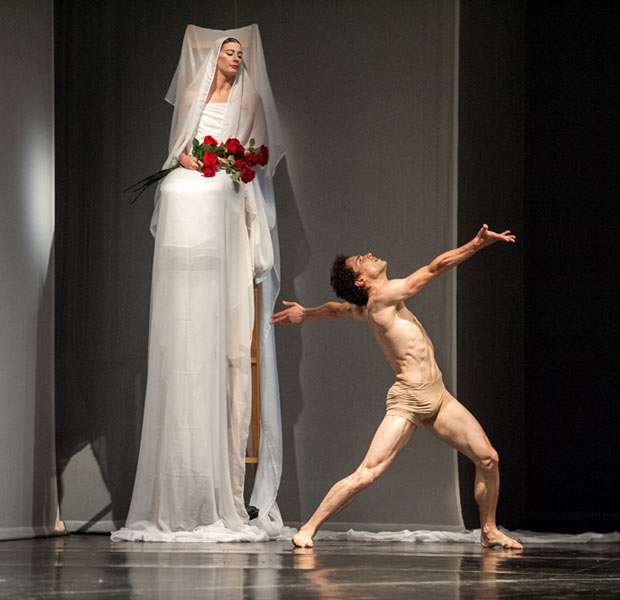
© Stephanie Berger. (Click image for larger version)
Paris Opera Ballet
Orpheus and Eurydice
New York, David H. Koch Theater
20 July 2012
www.operadeparis.fr
For the final performances of its New York run (until July 22), the Paris Opera Ballet chose to present Pina Bausch’s staging of Gluck’s Orfeo ed Euridice from 1975. As documented in Frederick Wiseman’s 2009 film La Danse, this is a company that likes to keep up with the times. Mats Ek, Sasha Waltz, Bausch, Wayne McGregor, and Forsythe have all left their mark. Brigitte Lefevre, the company’s artistic director, has made it clear that she has no interest in allowing her company to become a museum piece. The dancers’ exposure to Pina Bausch dates back to the early nineties when her company, Tanztheater Wuppertal, performed several times at the Opéra Garnier. In 1995 she allowed the Parisians to perform her Rite of Spring; in 2005 she gave them her Orpheus and Eurydice.
The merger of opera and dance is a tricky business, attempted occasionally and with varying degrees of success by opera impresarios and choreographers. How much should be expressed with movement, and how much through the voice? Should the singers appear onstage or be concealed in the pit, and should they interact with the dancers? In the baroque era ballet was embedded within opera, but even after the two evolved into separate entities, choreographers and composers have periodically dreamed up ways of putting them back together again. Diaghilev staged Rimsky Korsakov’s Le Coq d’Or as an opera-ballet in 1914, with choreography by Michel Fokine; Nijinska choreographed Stravinsky’s Le Renard, Histoire burlesque chantée et jouée, in 1922. More recently we’ve seen Mark Morris’s stagings of Purcell’s Dido and Aeneas and Satie’s Socrate (not quite an opera, but still); here, too, the singers are heard but not seen. In 2002, Trisha Brown went further, producing a Winterreise in which the singer, Simon Keenlyside, not only interacted with the dancers, but also engaged in some simple moves.
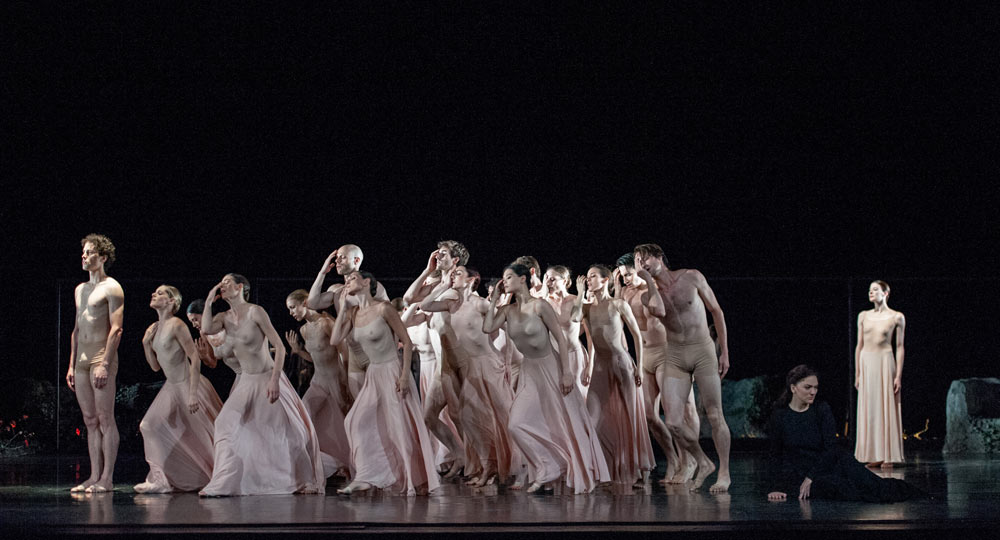
© Stephanie Berger. (Click image for larger version)
Gluck’s Orfeo, composed in 1762, is an obvious choice for choreographers. It is a transitional work, and relatively simple in its design. Here, Gluck introduced a new emotional directness in vocal writing; he also included quite a bit of dancing in his original design. There are two ballets written into the score. The music is familiar, even to opera agnostics. First comes the “Dance of the Furies,” with its slashing chords and careening scales; it is followed in short order by the seraphic flute melody of the “Dance of the Blessed Spirits,” a blissful minuet. (Balanchine choreographed the whole opera in 1936, and used the “Blessed Spirits” for his Chaconne in 1976.) Early in her career, Pina staged the opera for her own company and its themes are close to her heart: tormented love, loss, violence, and death. And though her Orpheus predates the tanztheater works for which she is best known, it foreshadows many of their key elements: the atmosphere of disorder and anguish, the obsessive reiterations, the long, formless dresses (for the women) and suits (for the men), and the oneiric mise-en-scènes.
Each of the characters is doubled, represented by a dancer and a singer, both onstage, usually in close physical proximity. The two figures seem to exist in parallel but overlapping worlds. (All the voices are female: a mezzo and two sopranos. The chorus, who plays an important role in the action, remains unseen.) The onstage singers are well integrated, though they are often forced to sing while kneeling or crouching or facing into a wall, which is not very conducive to sound projection. All three (Maria Riccarda Wesseling, Yun Jung Choi, and Zoe Nicolaidou) sang well, though they could not always be heard over the orchestra; all three looked elegant in their long black dresses.
Bausch re-thinks various elements of the opera. She omits Gluck’s up-tempo overture, as well as his final scene, in which Eurydice is restored to life. Her interest lies only in Gluck’s darker tonalities. Even her “Dance of the Blessed Spirits” is more mournful than serene. As the curtain opens, we see a striking tableau, an image straight out of a dream: A woman, held aloft, seems to hover in mid-air, a long white sheet concealing her face and draping all the way to the floor like a shroud. A tree lies on its side. A woman (Marie-Agnès Gillot, as Eurydice) perches on a frighteningly tall chair upstage right, remote and untouchable in a long white dress that skims the floor several meters below her; her hair is covered by a veil, a bouquet of blood-red roses lies in her lap. (She remains there for a long time, overseeing the scene). At the rear of the stage lies a glass enclosure. Downstage left stands a handsome man wearing only flesh-colored briefs; this is our Orpheus (Stéphane Bullion). This scene represents the mourning of Eurydice.
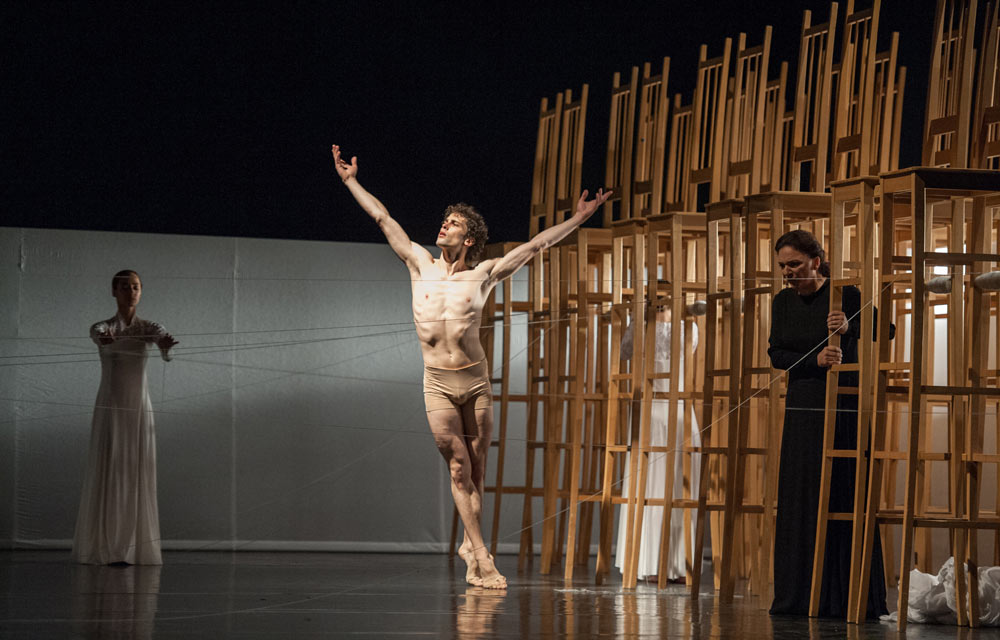
© Stephanie Berger. (Click image for larger version)
I had to re-read the libretto when I got home in order to make sense of what I had just seen. Bausch eliminates context, and subdivides the scenes into abstract thematic chunks: “mourning,” “violence,” “peace,” and “death.” The themes are relatively clear, but the underlying narrative and internal monologues of the characters are not. I’ll admit, I ached for surtitles in order to know exactly what the singers were going on about. I could tell they were sad, I could hear them invoke Eurydice’s name, but I wanted to know more. Without an understanding of the specifics of the text, one aria tends blends into the next. (Bausch has chosen to use the German version of the libretto; alas, “che farò senza Euridice” sounds much better than “ohne dich, ach Euridice.”) Many details were lost; it was not very clear at what point Orpheus entered the underworld, or how, exactly, he managed to wangle his way to Eurydice’s resting place in the first place. At some point, during the section entitled “Peace,” Eurydice simply appeared. Other mysteries: why, in the Underworld, is there a woman clutching a giant loaf of bread and another who reaches, endlessly, for an apple on a string?
The role of Orpheus, as Bausch has conceived it, is a thankless one. The dancer spends most of his time wandering about the stage, looking forlornly either up at the sky or down at the floor. While Eurydice dances her heartbreaking solo (a highpoint, at least in Gillot’s hands), he stands on the far side of the stage, facing a wall of fabric. At the end, as his vocal double sings his lament “ohne dich, ach Euridice,” he kneels with his back to the audience. Doesn’t he get cold, sitting there wearing almost nothing? And even when the choreography gives him something more concrete to do, it is not so different from what has been done before by other dancers: lunging, pliéing in second position, circling his torso from the waist, covering one eye with his hand, caressing his other arm. Perhaps a dancer with a more compelling presence would have brought out the differences, but Stéphane Bullion, though extremely handsome—like a boy in a Pasolini movie—looks rather clueless most of the time. This is Orpheus, who could tame wild animals with his music?<
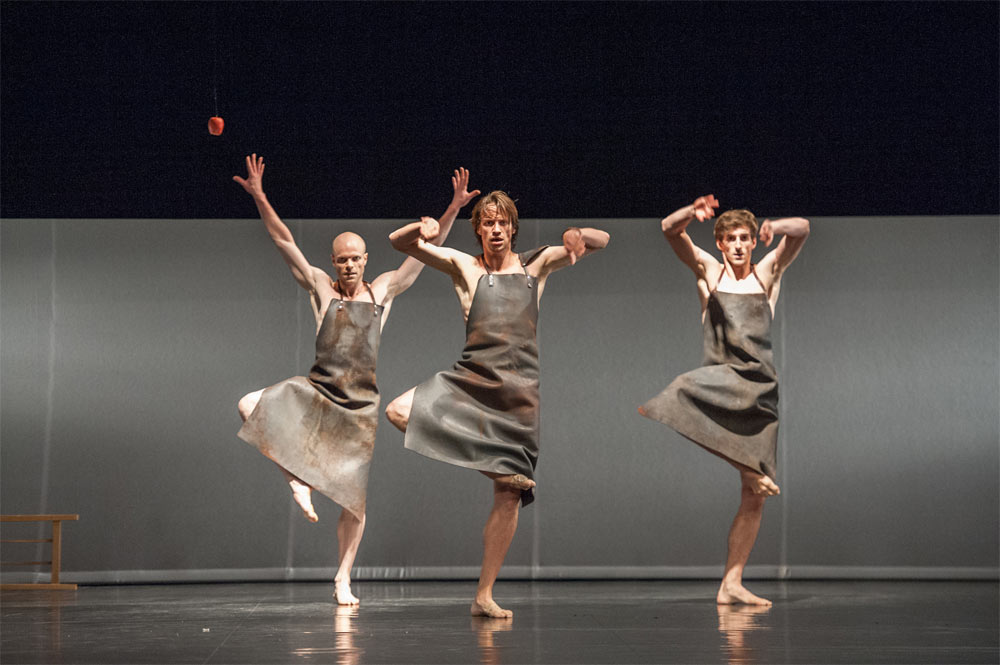
© Stephanie Berger. (Click image for larger version)
One of the prettiest sections takes place in the section called “Peace.” Here is the dancing of the Blessed Spirits, a small ensemble of women in long, flowing flesh-colored dresses. The movement is lyrical and lovely, and the dancers reveal far greater fluidity in the torso than they allowed themselves in Giselle. The steps, though quite similar to those of the mourners in the opera’s first scene, have a different quality: soft, flowing, serene. (To my eye the monotony of Bausch’s movements for the feet and legs is one of the most frustrating aspects of her work.) The dancers’ eyes are downcast; blessed, yes, happy, not so much. There is a bit of partnering: low, gliding lifts that change position in midair. (Alice Renavand stood out for her sensuality.) It’s all very lovely and fluid, but is it interesting? (To me, the answer is no.) More exciting was the scene that came before, “Violence,” in which tall, strapping men in leather aprons lunged and crept, slapped their thighs, and sliced the air with their arms. (Vincent Cordier was especially impressive here.) Bausch has always had a knack for glorifying the manliness of men.
Just as the repetition began to take its toll, Marie-Agnès Gillot came to save the day. Eurydice does not really enter the scene until the very end of the third section. But she dominates the final scene, with a Graham-like solo in which she slashes and contracts, curves her back and weeps, desperation personified. It’s not really the choreography that chills the blood; it’s Gillot. With her Modigliani face, angular limbs, and amazingly articulate back, she makes the simplest movement look interesting. In a recent profile for Dance magazine, Brigitte Lefèvre said of her that “she actually changes the space around her when she enters the stage.” And how. Suddenly, a gesture repeated many times before—a hand wiping the face—acquires deep resonance. When Gillot kicks her long leg into a swinging arabesque and opens her arms, she is a force that will not be denied. As a young girl, Gillot suffered from double scoliosis and was forced to wear brace; the sheer willpower and raw physical strength needed to overcome this torment shines through in her dancing. Bausch must have loved her.
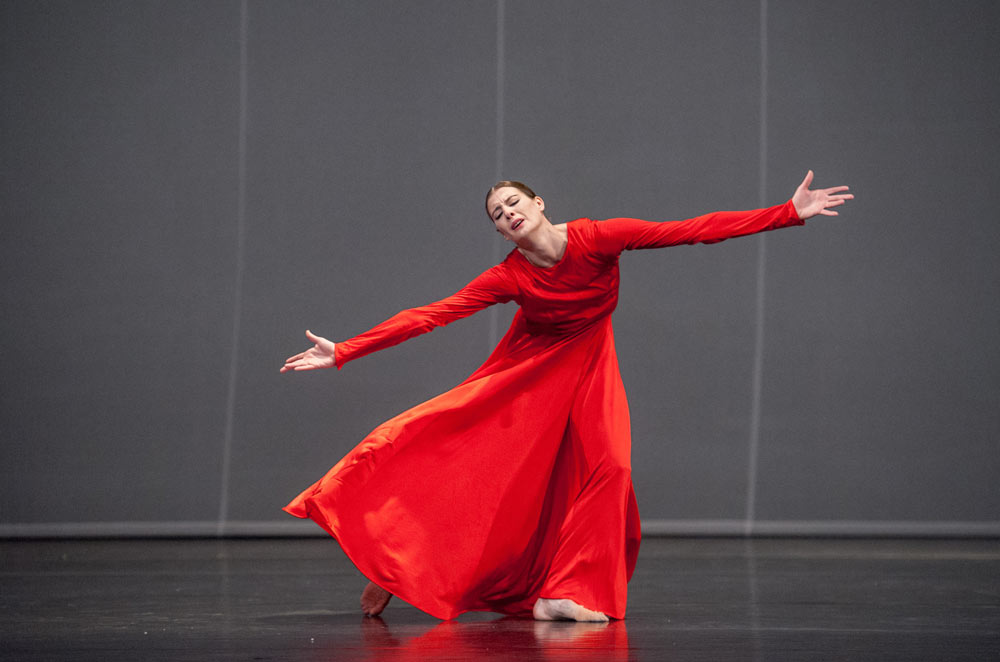
© Stephanie Berger. (Click image for larger version)
But is it enough? Bausch is a mystery. To some, she represents the summit of poetry and expression, worthy of a cult-like following. Clearly, these dancers derive great emotional sustenance from performing her work. And it suits them. But, with the exception of Gillot’s solo and a few moments here and there, it left me cold.












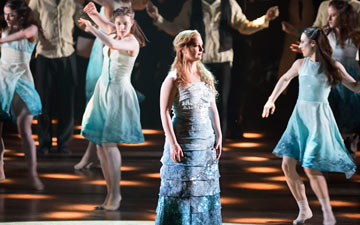
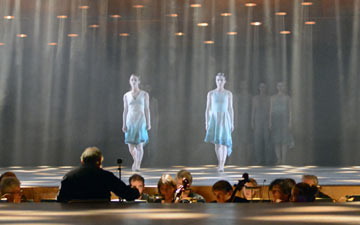
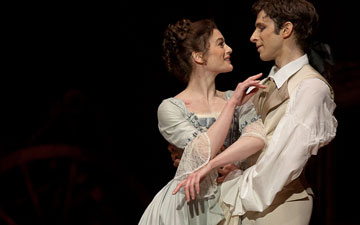

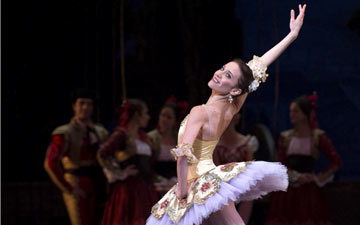
Thank you for this — I just saw it today, Sunday, its last performance, and had just the same reaction. I’m especially grateful for your comment about the loaf of bread! If that’s what it was. Why the Lincoln Center program couldn’t have supplied us with a little more info is hard to understand. I do see why they wouldn’t have wanted supertitles, given the amount of movement to be followed on stage. But why not a synopsis of the version of the story being presented to us?
I for one was looking forward to seeing Orpheus arguing with Hades and Persephone, but they were apparently otherwise engaged.
I am not a professional, I am just a ballet lover, and I like Friday performance. Yes, it contains a lot of mystery and because it’s in German, it adds some misunderstandings too, but dance should be a mystery!!!!
And dance should let diversity of understandings, and probably that’s what Bausch achieved by her choreography. For me one thing was missing (and once more it could be also choreographic design, – some real face expression in Orpheus, he danced great but his face was so emotionless that you do not understand why he should be asked do not look to Euridica, he is not looking to anyone….
Thanks, Marina, for a typically informative and sensitive review. I was at Friday’s performance and loved it. For me Pina Bausch creates what I think of as dream-state liturgies. There is a repetitiveness and mysteriousness in the movements and symbolic actions she creates that feel like/work like sacred rituals. They cannot be grasped with the intellect alone (a point Rosalyn Sulcas makes in her review of Pina’s World Cities “marathon” in London (NYT 7/13/12)). All I know is that I left the theater refreshed and grateful.
Even when we have very different experiences, you are one of my favorite dance writers. Thank you!
Dear Judy, Brendan and Poetry29,
Thank you all for your heartfelt comments.
Alas, I find myself un-moved by Bausch’s poetic imagination, at least in this case. Even as I tried to quiet the critical side of my brain, it balked, for all the reasons I describe above. And yet, I see that many are moved, and I respect Bausch’s sense of theatre. I felt a similar transport after seeing Mark Morris’s “Socrates,” which is equally economical in its means. Both my mind and my heart were engaged—the ultimate extasy.
Cheers, and thanks for reading,
M
or rather, the ultimate ecstasy…
It is always a pleasure to read your reviews, Marina!
I often find that you are able to take something I was feeling about a performance but couldn’t quite articulate and express it perfectly!
I also had mixed feeling about this piece, but one thought did occur to me regarding the “giant loaf of bread” and apple. I thought it was not a loaf of bread, but a rock, which made me think that the dancer was a representation of Sisyphus, who must roll a boulder up a hill endlessly. Similarly, I thought the woman reaching for the apple was Tantalus, forever reaching for the fruit just out of reach…
Keep up the great work!
[…] Read it here, in DanceTabs. […]